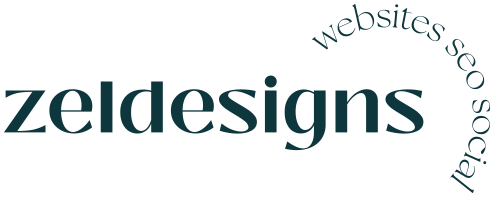We believe knowledge is power. So we have put together a list of popular website design words and terms to help you navigate your web design journey. Our website glossary will evolve over time as we continue to add to this list.
Backend
The ‘backend’ of a website refers to the section of the CMS that your clients do not see. This is where you edit pages, images and posts. As well as themes and plugins.
Backlinks
Backlinks are websites that link to your website. For example website A writes website b’s domain name (and hyperlinks it) on their website this is classed as a backlink to Website B. Backlinks are currently GOLD in the SEO world.
Bandwidth
Bandwidth is the amount of data you are allowed to transfer to and from your web server, usually per month. It depends on the size of your website pages, the number of visitors and how many pages they visit.
Bounce rate
A bounce rate is the term used to measure visitors leaving your website before doing anything. It represents the percentage of visitors who enter the site and then leave before continuing on to other pages. Hint: a lower bounce rate is your aim.
Bandwidth
Bandwidth is the amount of data you are allowed to transfer to and from your web server, usually per month. It depends on the size of your website pages, the number of visitors and how many pages they visit.
Browser
Also known as a web browser or internet browser, a browser is a software program that allows its users to access the World Wide Web. Some popular browsers are Google Chrome, Apple Safari and Microsoft Edge.
Cache / Caching
A cache is a special storage process that holds temporary files which allows a website to load faster.
Cascading Style Sheets (CSS)
A CSS is a website element that dictates how HTML files are to be viewed on various screens.
This means a CSS is used to style your website, including the design, layout and different displays per device and screen size.
Content Management System (CMS)
A Content Management System (abbrev. CMS) is a computer software program that allows users to create, manage and modify content on a website.
For example, WordPress is an extremely popular CMS.
DNS (Domain Name Server or Domain Name System )
Domain name system is a system that connects nice user friendly domain names to computer friendly addresses, IP address. This computer address is where your website files are stored (hosted).
Domain
A domain is a web address. It is a user friendly name that connects your visitors to your website. There are various domain options available. For example zel.design or zeldesigns.com.au. The domain name is connected to an IP address & DNS.
E-Commerce
An e-commerce site is an electronic shop. It allows you to sell your products online around the world.
For example, Shopify and Woocommerce are options available for you to get your products online.
Front End
The front end of your website is what a user sees and interacts with when they visit your website. Whilst it sounds technical, front end is just what you see when you look at any website. It is responsible for the look and feel of the users online experience.
HTML
HTML stands for Hyper Text Markup Language. It is code used to create websites and it describes the structure of a website. A web browser uses these HTML tags to determine how to display the website.
HTML link to CSS (and JavaScript) to look good.
HTTP
HTTP stands for Hyper Text Transfer Protocol. The primary function of HTTP is to establish a connection with the server and send HTML pages back to the user’s browser.
HTTPS
HTTPS (HTTP Secure) is the encrypted version of HTTP. See above.
Hyperlink
A hyperlink (also referred to as simply a link) directs a user to a different page / website /section of a website just by tapping or clicking the text. The text that the hyperlink is linked from is called an anchor text.
A hyperlink can point to a specific website page or to a specific section within a website.
Landing Page
A landing page is the page a visitor arrives at on your website. This can be after clicking an ad, Google search or social post. Essentially, it is the first page someone enters your website.
Meta Data
Metadata is data that describes other data. Your website is the main ‘data’ and your metadata is shortened descriptions of your website. For example a website page has a meta title and meta description for each page on your site. These metadata elements help Google and other search engines determine if your website is relevant to the search term. It also helps visitors decide when they are searching for you. Google shows your title and description in the search results.
Navigation
Website navigation is how your visitors work their way through your website. Usually in the form of a menu which is a set of hyperlinks linking to internal pages on your website.
Page View
A page view is a metric taken by Google analytic (and WordPress ) to show you how many times a specific page on your website has been loaded (seen).
Permalink
A permalink (or permanent link) is a full URL that you see (and link too) for each website page, post, media and more. A permalink is your domain name (www.zel.design) plus the contents slug.
Plug in
A plug-in is an extension of the existing software/ program. As for WordPress, plugins add functions that are not part of the base WordPress package. Plugins give you the ability to change your website to be as flexible and unique as you want it to be. All without adding code yourself.
Resolution
Resolution refers to the detail in a particular image or screen. The resolution of an image is typically measured in pixels per inch (PPI) or dot per inch (DPI). These two measurements determine the amount of information displayed within a certain area.
Higher resolutions mean that there are more pixels per inch (PPI), resulting in more pixel information and creating a high-quality, crisp image. Images with lower resolutions have fewer pixels.
As a rule of thumb, screens use graphics that are 72 dpi (which results in smaller file sizes and quicker load times) and printed materials use a higher dpi of 300.
Slug
A slug is the part after your domain name in a URL. It Identifies a particular page on a website. In other words, it’s the part of the URL that explains the page’s content. For example, the URL of this page could be https://zel.design/website-glossary-terms-you-need-to-know , and the slug is ‘website-glossary-terms-you-need-to-know’.
Theme
Every WordPress website needs a theme. WordPress themes are either free or premium. Themes are in charge of the layout and design of the website. They customise the appearance of your site. For example, the layout, font, colour and more.
URL
URL stands for Uniform Resource Locator. It is a fancy way of saying an address to find your website files. Every valid URL points to a unique ‘resource’. Examples of resources are HTML page, a CSS file and images.
A URL is your domain name and the slug combined.
Web Server
A web server is where your website files are stored (hosted). In short, it is a computer that runs websites. It’s job is to store, process and deliver websites to users.
And that’s a wrap…. of our website glossary
We are continually adding to our website glossary.
Do you think we have missed a key term for web design in our website glossary? We would love to hear from you.





